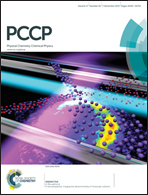H2O–CH4 and H2S–CH4 complexes: a direct comparison through molecular beam experiments and ab initio calculations
Abstract
New molecular beam scattering experiments have been performed to measure the total (elastic plus inelastic) cross sections as a function of the velocity in collisions between water and hydrogen sulfide projectile molecules and the methane target. Measured data have been exploited to characterize the range and strength of the intermolecular interaction in such systems, which are of relevance as they drive the gas phase molecular dynamics and the clathrate formation. Complementary information has been obtained by rotational spectra, recorded for the hydrogen sulfide–methane complex, with a pulsed nozzle Fourier transform microwave spectrometer. Extensive ab initio calculations have been performed to rationalize all the experimental findings. The combination of experimental and theoretical information has established the ground for the understanding of the nature of the interaction and allows for its basic components to be modelled, including charge transfer, in these weakly bound systems. The intermolecular potential for H2S–CH4 is significantly less anisotropic than for H2O–CH4, although both of them have potential minima that can be characterized as ‘hydrogen bonded’.



 Please wait while we load your content...
Please wait while we load your content...